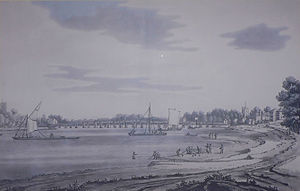Putney Bridge
Putney High Street, a main approach, is part of a London hub for retail, offices, food, drink and entertainment.
This close proximity of two churches by a major river is rare, another example being at Goring-on-Thames and Streatley, villages hemmed in by the Chiltern Hills (the Goring Gap).
According to an account from the period:The Lord-Generall hath caused a bridge to be built upon barges and lighters over the Thames, between Fulham and Putney, to convey his army and artillery over into Surry, to follow the King's forces; and he hath ordered that forts shall be erected at each end thereof to guard it; but for the present the seamen, with long boats and shallops, full of ordnance and musketeers, lie there upon the river to secure it.
[2]In 1720 Sir Robert Walpole (the following year considered the first Prime Minister) was returning from seeing George I at Kingston on Thames and being in a hurry to get to the House of Commons rode together with his servant to Putney to take the ferry across to Fulham.
Walpole, who was left to take a longer route to Parliament, seemed to be motivated by the experience to have a bridge built across the Thames between Fulham and Putney.
Built by local master carpenter Thomas Phillips to a design by Royal Navy Surveyor Sir Jacob Ackworth, the first bridge was opened on 29 November 1729.
[4] In October 1795, Mary Wollstonecraft, philosopher and early women's equality advocate, allegedly planned to commit suicide by jumping from the bridge, because she had returned from a trip to Sweden to discover that her lover was involved with an actress from London.
The bridge was designed by civil engineer Sir Joseph Bazalgette as a five-span structure, built of stone and Cornish granite.
[12][13] Irish playwright Sonya Kelly wrote a play, Once Upon a Bridge, inspired by the incident which was produced by Druid Theatre in 2021.

